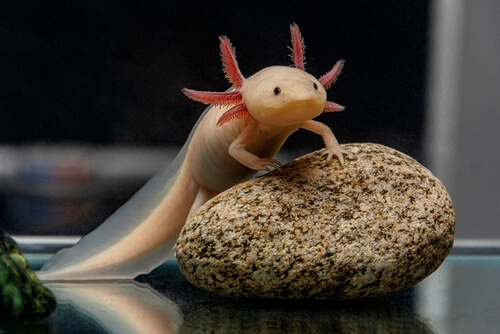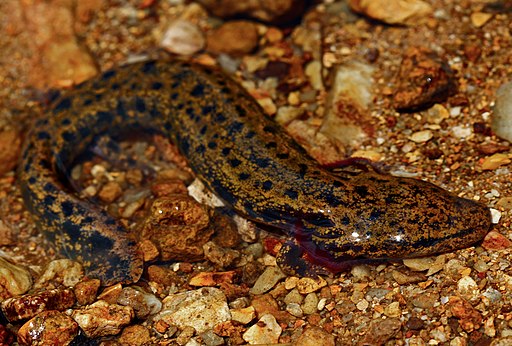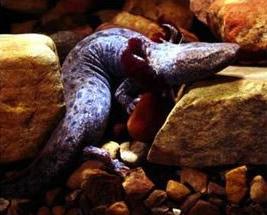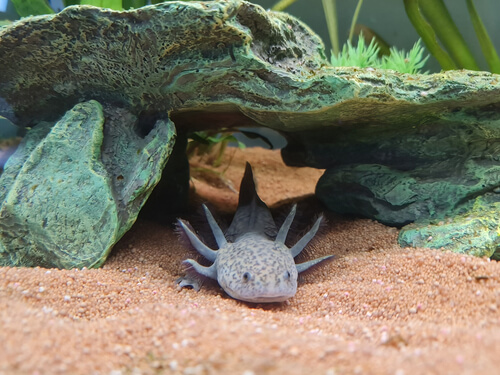Axolotl vs Mudpuppy: What’s the Difference?
Posted by on 4/27/2023
Axolotls and Mudpuppies are two similar-looking freshwater amphibians that are two completely separate species. While both aquatic amphibians fall under the Urodela order, they share a set of similarities and differences that hobbyists should be aware of before considering them as their next pet.
In this post, we’ll summarize the two species, and we’ll also outline some of the key similarities and differences hobbyists should be aware of before deciding whether or not one of these amphibians is the right choice for you.
Axolotls
Popular video games Minecraft and Fortnite have made this freshwater amphibian soar in popularity over the past few years. The Axolotl (scientific name: Ambystoma mexicanum) is a critically endangered species with a large number of unique characteristics. The species may be best known for its capability of regenerating its limbs, parts of its brain, eyes, and gills.
Named after the Aztec deity Xolotl, Axolotls can be found exclusively in Mexico City’s Lake Xochimilco . Luckily for hobbyists, the species is widely bred in captivity, and few are exported from their native habitat.
Interestingly, the species is neotenic , which means that they retain their juvenile characteristics into adulthood.
Shop 👉 Leucistic Axolotls ($80) from AquaJin

Mudpuppies
The genus Necturus is commonly referred to as mudpuppies, but it is the Common Mudpuppy (scientific name: Necturus maculosus) that is perhaps the most popular in the amphibian-keeping world.
The species hails from the eastern part of North America and can be found in the states of Tennessee, Ohio, Indiana, Michigan, Wisconsin, and further north between the New York-Ontario border. Similar to axolotls, mudpuppies are also neotenic, and keep their juvenile characteristics as adults.
Like other amphibians, these salamanders thrive in lakes, rivers, and ponds, where their brown coloration helps them blend in with the surrounding environment.

Similarities
Hobbyists considering a Mudpuppy or Axolotl as the next addition to their amphibian tank will quickly notice some of the similarities between both species.
It is not uncommon for hobbyists to accidentally confuse a mudpuppy for an axolotl.
Diet
In the wild, mudpuppies consume insect larvae, mollusks, small fish, earthworms, and even spiders.
Similarly, Axolotls also consume mollusks, worms, and small fish.
Hobbyists should look to recreate their native diets as closely as possible, and a diet consisting of blackworms, daphnia, raw meat, brine shrimp, and nutrient-rich pellet foods will suffice.
🛒 Shop Freshwater Fish on Light Fish
Tank Size
Although mudpuppies are slightly larger when compared to axolotls, a single mudpuppy or an axolotl can be housed in a 20-gallon tank.
Providing them with pristine water conditions is an absolute must, as both amphibians tend to be quite messy.
Lifespan
Axolotls and Mudpuppies are long-lived amphibians. In the wild, both have an average lifespan of about 10 years.
However, in captivity Axolotls can live for up to 20 years, while Mudpuppies can live for a whopping 30 years! Hobbyists considering either should be prepared to care for the species for a long time or have a rehoming plan in place.
Differences
Although both Axolotls and Mudpuppies share the same ancestral order, Axolotls are members of the Ambystomatidae family, while the common mudpuppy is a member of the Proteidae family.
Both species appear in different parts of the world, so it's no surprise that there are quite a few differences between the two.
Size
Adult axolotls typically grow to reach about 12 inches in length. On the other hand, adult mudpuppies can grow to be much larger, and some have been recorded to reach 17 inches in length.
Diet and a pristine environment remain a big factor in both axolotls and mudpuppies reaching their healthy adult size.
Appearance
Axolotls and Mudpuppies share similar anatomy. Both species contain external gills that protrude from their bodies behind their eyes. Their frontal limbs have four finger-like digits, while their hind limbs have 5 digits. Similar to other salamanders, both have grooves between their ribs which contain nerves and blood vessels.
Both axolotls and mudpuppies are capable of locating food by their sense of smell, which is much stronger than their eyesight.
However, there are some differences in coloration. Axolotls can change their colors as a form of camouflage, while the common mudpuppy has a brown coloration.
Breeders have also crossbred Axolotls to accentuate distinct colorations, with the albino, mosaic, and leucistic color morphs being a few of the most common.

Distribution
Axolotls can be found exclusively in Lake Xochimilco but were also previously found in Lake Chalco , which has since been drained.
Mudpuppies are located along the eastern part of the United States and the southeastern Canadian border. They are quite common and are often accidentally caught by fishermen, who release them back into the waterways.

Legality
It is illegal to own an Axolotl in some U.S. states. California, Maine, New Jersey, and Washington D.C. do not allow the species to be kept, and New Mexico and Hawaii require permits. These U.S. state limitations are largely due to the species being endangered and the potential impact they could have on local wildlife if released.
Mudpuppies are safe to own throughout the United States, however, there are some limitations on collection. In the state of Iowa, they are illegal to kill and collect .
Where to Purchase
Axolotls and Mudpuppies frequently appear on the amphibians section of our marketplace, but hobbyists looking to purchase the species in person should phone up their local fish stores.
Although these species are amphibians, they're frequently kept by aquatic fish store owners who have large quantities of tanks to house them in.
🛒 Shop Aquarium Plants Fish on Light Fish
Conclusion
Both Axolotls and Mudpuppies are fascinating amphibians to care for. While these species share plenty in common, their unique differences may sway your decision on which should be the next addition to your tank.
So now that you've learned a bit about both amphibians, which do you think you'll choose? Let us know in the comments, and be sure to visit our marketplace and community forum.
December's Giveaways on Light Fish


















